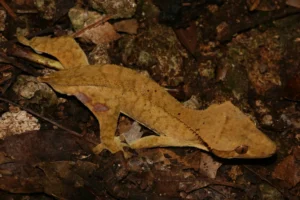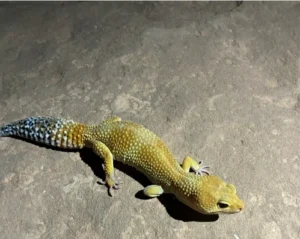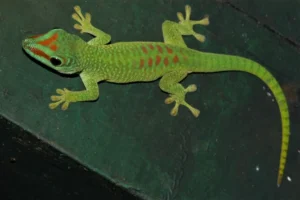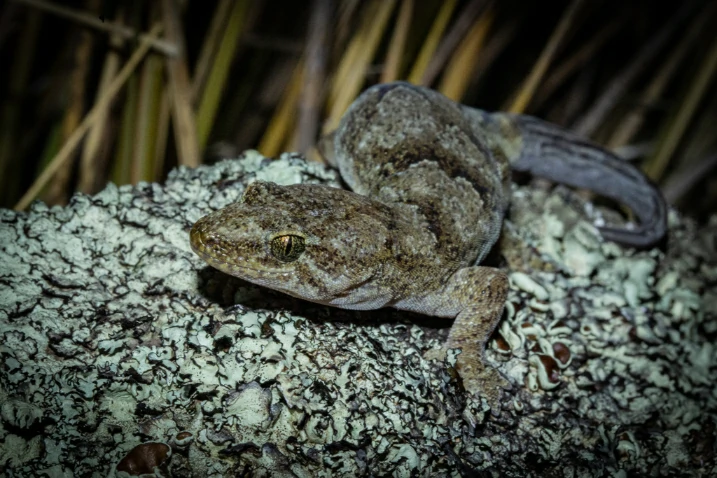It’s evening, and the soft light in your gecko’s tank makes its skin look a little different than it did an hour ago. One moment it seemed a rich brown, and now it’s almost golden with subtle patterns showing through. You blink and think, wait, do geckos actually change color? And if they do, do all geckos do it?
No, not all geckos change color, but a lot of species can adjust their skin in small or big ways. Some geckos shift colors to blend into their surroundings, show their mood, communicate with other geckos, or even manage their body temperature. Others barely change at all, keeping the same colors and patterns most of the time.
Basically, whether a gecko changes color depends on the species, where it lives, and even the individual gecko.
How Geckos Change Color
Color change in geckos isn’t magic. It’s controlled by special cells in their skin called chromatophores.
These cells hold pigments, and by expanding or shrinking, they change how much color you see.
There are three main types of these cells:
-
Melanophores: Control black and brown pigments
-
Xanthophores: Control yellow pigments
-
Iridophores: Reflect light to make blues, greens, or shiny effects
When these cells work together, a gecko can shift color a little, or a lot. Some species only lighten or darken slightly, while others can make patterns appear or disappear depending on their surroundings.
Gecko Species and Their Color-Changing Abilities
To make it easier, here’s a table of 15 common gecko species, showing which ones can change color, how, and why:
| Gecko Species | Can Change Color? | Type of Color Change | Reason for Color Change |
|---|---|---|---|
| Leopard Gecko (Eublepharis macularius) | No (slight) | Minor darkening/lightening | Temperature, mood, stress |
| Crested Gecko (Correlophus ciliatus) | Yes | Brightness and pattern shift | Camouflage, mood, temperature, social signaling |
| Tokay Gecko (Gekko gecko) | Yes | Darker or lighter spots | Stress, aggression, environmental changes |
| Gargoyle Gecko (Rhacodactylus auriculatus) | Yes | Pattern and shade changes | Camouflage, temperature, mood |
| Day Gecko (Phelsuma spp.) | Yes | Brightness and hue shifts | Camouflage, temperature, social signaling |
| Mediterranean House Gecko (Hemidactylus turcicus) | Yes (subtle) | Pale or darker grey | Temperature, stress, light conditions |
| African Fat-Tailed Gecko (Hemitheconyx caudicinctus) | No (slight) | Slight darkening | Temperature, activity level |
| Satanic Leaf-Tailed Gecko (Uroplatus phantasticus) | Yes | Pattern blends with environment | Camouflage (predator avoidance) |
| New Caledonian Gecko (Rhacodactylus leachianus) | Yes | Darker or lighter shades | Camouflage, mood, temperature |
| Mourning Gecko (Lepidodactylus lugubris) | No | Minimal | Mostly fixed coloration |
| Tokay Subspecies (Gekko g. gecko) | Yes | Darkening or lightening of spots | Stress, aggression, environmental adaptation |
| Flat-Tailed Gecko (Uroplatus spp.) | Yes | Pattern and brightness shift | Camouflage, mimicry of leaves/bark |
| African Day Gecko (Lygodactylus spp.) | Yes | Brightness and hue adjustments | Camouflage, temperature, mood |
| Pachydactylus Geckos | No (slight) | Slight shade changes | Temperature and light level |
| Bibron’s Gecko (Chondrodactylus bibronii) | No (slight) | Minor darkening/lightening | Temperature, stress |
Most geckos that change color a lot are tropical or live in trees. Many others only adjust slightly for temperature or mood.
Geckos That Commonly Change Color
Not every gecko is a color-changing superstar. Some of the most noticeable ones are:
1. Crested Geckos
Crested geckos are great at subtle changes. Their skin can lighten or darken based on:
-
Temperature: Cooler areas make them look darker
-
Time of day: They often lighten at night, darken during the day
-
Mood or stress: Excited or stressed geckos may show brighter colors

Their patterns don’t fully disappear, but the contrast between the main color and markings can shift a lot.
2. Tokay Geckos
Tokays are vivid with blue and orange patterns. They don’t change color like chameleons, but they can lighten or darken depending on stress, mood, or temperature.

A relaxed tokay may look paler, while a defensive one can appear more intense.
3. Leopard Geckos
Leopard geckos don’t change as much as crested or tokay geckos, but young ones are often darker with stronger patterns that fade as they grow.

Some captive-bred morphs even look different under day versus night light, though it’s not true color change like crested geckos.
4. Day Geckos
Day geckos are bright green, especially those from Madagascar. They can darken slightly under stress or different temperatures and light.

It’s not dramatic, but it helps them hide or send subtle signals to other geckos.
Why Geckos Change Color
Color changes in geckos usually have a purpose:
1. Camouflage
Many geckos shift color to blend in. A brown gecko on bark becomes less visible, while a lighter gecko on leaves or sand can avoid attention.
Crested geckos on reddish bark may darken to match, while the same gecko on light leaves may appear pale. It’s a way to stay safe.
2. Temperature Regulation
Geckos are cold-blooded, which means they rely on the environment to manage their body heat. Dark skin absorbs more heat, light skin reflects it.
A gecko in a warm spot might lighten to avoid overheating, while one in a cool spot might darken to soak up warmth.
3. Mood and Communication
Color shifts can show mood or stress. Geckos may darken when stressed or defensive, and lighten when relaxed.
In social species, color can signal to other geckos:
-
Darker hues: Warning or defensive posture
-
Lighter shades: Calm or non-threatening
This “silent language” helps geckos avoid fights.
4. Health Indicators
Sometimes color changes hint at health. Pale or dull skin can mean illness, poor diet, or dehydration. Very dark or blotchy skin might show stress, sickness, or that the gecko is shedding.
Watching these changes helps you catch problems early.
Geckos That Don’t Change Color Much
Some geckos mostly keep the same tones and patterns:
-
House geckos: Usually light brown or gray, with little change
-
Mediterranean geckos: Often uniform gray or tan, barely changing with mood or temperature
For these geckos, color isn’t for camouflage or communication as much as it is just their usual look.
Shedding and Color Change
A lot of color shifts happen when geckos are shedding. Their skin may look dull or hazy right before shedding. This doesn’t last, colors return once shedding is done.
During this time, geckos may hide or move less, which can make the change more obvious.
Conclusion
So, do all geckos change color? No, but many do, and how much they change depends on the species.
Some, like crested and day geckos, can shift colors subtly or dramatically. Others, like common house geckos, stay mostly the same.
Color change helps geckos blend in, communicate, manage body temperature, and even show health.
Next time you see your gecko looking different, don’t worry; it’s probably just responding to its environment or how it feels.
Watching these shifts gives you a peek into the small but amazing world of gecko behavior.
Hi, my name is Ezra Mushala, i have been interested animals all my life. I am the main author and editor here at snakeinformer.com.

